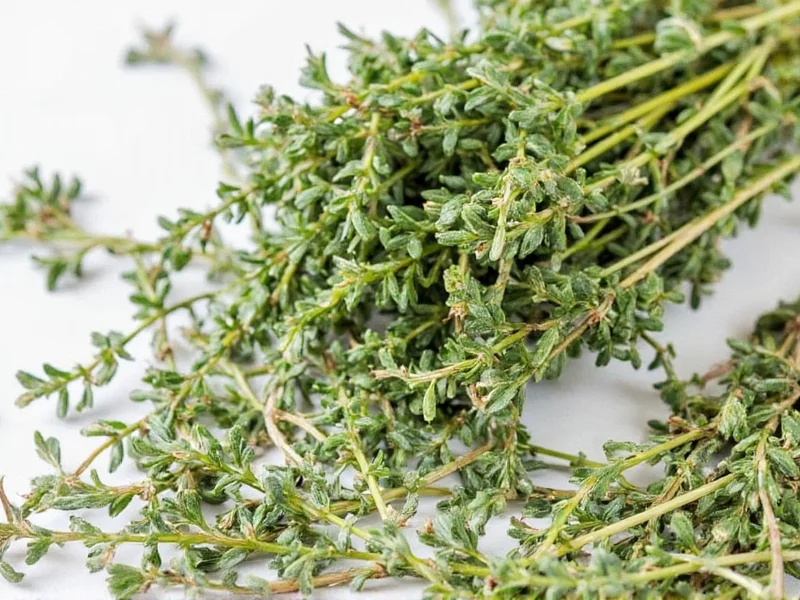When substituting fresh thyme for dried in recipes, understanding the precise conversion ratio prevents under-seasoning or overpowering your dishes. The standard culinary guideline states that 1 tablespoon of fresh thyme leaves equals 1 teaspoon of dried thyme. This 3:1 ratio exists because the drying process removes moisture while concentrating the essential oils and flavor compounds.
Why the 3:1 Fresh to Dried Thyme Ratio Matters
Thyme undergoes significant chemical changes during dehydration. Fresh thyme contains approximately 85% water, which evaporates during drying, leaving behind a more potent herb. Dried thyme delivers intensified flavor because the essential oils become more concentrated without water dilution. Using equal measurements would result in dishes that taste either bland (when substituting dried for fresh) or overwhelmingly herbal (when using fresh instead of dried).
Thyme Conversion Reference Chart
| Measurement | Fresh Thyme | Dried Thyme |
|---|---|---|
| Basic Ratio | 3 parts | 1 part |
| Teaspoon | 1 teaspoon | ⅓ teaspoon |
| Tablespoon | 1 tablespoon | 1 teaspoon |
| Cup | 1 cup | ⅓ cup |
| Stem Measurement | 1 sprig (about 1 inch) | ¼ teaspoon |
Practical Application in Cooking
When following recipes that specify thyme measurements, consider these practical tips for perfect seasoning:
- Adjust for dish type: For long-simmering dishes like stews, use ¾ of the recommended dried thyme amount since flavors intensify over time
- Timing matters: Add dried thyme early in cooking to allow rehydration, while fresh thyme works best added in the last 10-15 minutes
- Taste as you go: Always adjust seasoning at the end, especially when converting between fresh and dried forms
- Consider thyme variety: Lemon thyme and other specialty varieties may have slightly different potency levels
Fresh vs. Dried Thyme: Flavor Profile Comparison
Fresh thyme offers bright, grassy notes with subtle floral undertones, while dried thyme develops deeper, earthier characteristics. The drying process transforms thymol (the primary flavor compound), creating more complex aromatic compounds. In blind taste tests, professional chefs consistently identify these key differences:
- Fresh thyme: Best for delicate dishes like fish, salads, and finishing sauces where vibrant herbal notes shine
- Dried thyme: Ideal for robust preparations like braises, soups, and spice rubs where concentrated flavor penetrates ingredients
- Flavor intensity: Dried thyme maintains potency for 6-12 months when stored properly, while fresh thyme peaks within 3-5 days
Storage Techniques for Maximum Freshness
Proper storage significantly impacts thyme's flavor potency, affecting your conversion accuracy:
Fresh thyme: Treat like cut flowers—trim stems, place in water-filled jar, cover loosely with plastic bag, and refrigerate. This method extends freshness to 10-14 days. Avoid washing until ready to use, as excess moisture accelerates spoilage.
Dried thyme: Store in airtight containers away from light and heat. Properly stored dried thyme maintains optimal flavor for 6 months, gradually losing potency over 1-2 years. Test viability by rubbing between fingers—if aroma remains strong, it's still usable.
Avoiding Common Thyme Substitution Mistakes
Cooks frequently make these errors when converting between fresh and dried thyme:
- Ignoring recipe timing: Adding dried thyme too late in cooking prevents proper flavor integration
- Measuring whole sprigs: Failing to strip leaves from stems leads to inaccurate measurements (stems contain minimal flavor)
- Over-packing dried herbs: Scooping dried thyme directly from container compacts it, yielding too much herb
- Not adjusting for age: Older dried thyme loses potency, requiring slightly more than standard conversion
When Fresh and Dried Aren't Interchangeable
Certain culinary applications demand specific thyme forms for optimal results. In Mediterranean seafood dishes, fresh thyme's delicate flavor complements fish without overpowering. Conversely, dried thyme works better in slow-cooked bean dishes where its concentrated flavor withstands long cooking times. Some traditional recipes like French bouquet garni specifically require fresh thyme stems for proper flavor release during simmering.
Expert Tips for Perfect Thyme Measurements
Professional chefs recommend these techniques for precise thyme usage:
- Strip fresh thyme leaves by running fingers down the stem toward the tip
- Use measuring spoons for dried thyme—never estimate "a pinch" for critical recipes
- For dried thyme, lightly spoon into measuring tool then level—don't pack
- When in doubt, start with ⅔ of the converted amount, then adjust to taste
Can I use dried thyme instead of fresh in all recipes?
While you can substitute dried for fresh thyme in most recipes using the 1:3 ratio, certain dishes work better with specific forms. Delicate preparations like fish dishes, salads, and finishing sauces typically benefit from fresh thyme's brighter flavor, while robust dishes like stews, soups, and spice rubs often work better with dried thyme's concentrated flavor.
How do I convert thyme stems to measurements?
One average thyme sprig (about 1 inch of stem with leaves) yields approximately ¼ teaspoon of fresh thyme leaves. For dried thyme, this would convert to ⅛ teaspoon. Always strip leaves from stems before measuring, as stems contain minimal flavor compounds.
Does the conversion ratio change for different thyme varieties?
Most common thyme varieties (English, French, lemon) follow the standard 3:1 fresh-to-dried ratio. However, specialty varieties like caraway thyme or orange thyme may have slightly different potency levels. When using specialty varieties, start with ⅔ of the standard conversion amount, then adjust to taste.
How can I tell if my dried thyme has lost potency?
Rub a small amount of dried thyme between your fingers. If the aroma is faint or musty rather than strong and herbal, the thyme has lost significant potency. Properly stored dried thyme maintains optimal flavor for 6-12 months. When in doubt, use 25% more than the standard conversion ratio for older dried thyme.
Should I adjust thyme measurements for slow cooker recipes?
Yes, reduce dried thyme by 25% in slow cooker recipes since flavors intensify during long cooking times. For example, if a recipe calls for 1 teaspoon dried thyme, use ¾ teaspoon instead. Fresh thyme generally doesn't require adjustment in slow cookers as its more delicate compounds benefit from extended cooking.











 浙公网安备
33010002000092号
浙公网安备
33010002000092号 浙B2-20120091-4
浙B2-20120091-4